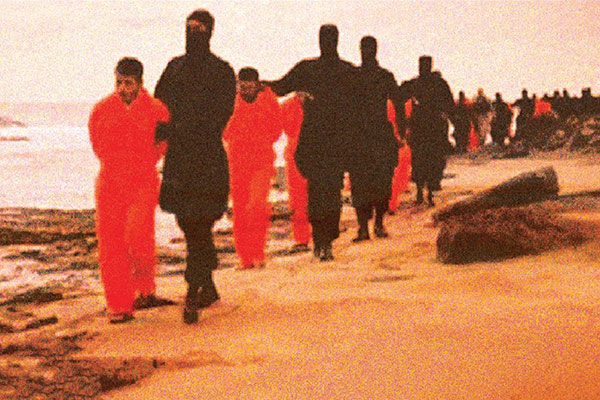Subtotal: $
Checkout
As Long as There Are Christians There Will Be Martyrs
How did twenty-one young Coptic Christians find the fortitude to face martyrdom at the hands of ISIS in 2015?
By Martin Mosebach and Alta L. Price
February 15, 2023
From The 21: A Journey into the Land of Coptic Martyrs by Martin Mosebach, translated by Alta L. Price.
The picture on the cover of a magazine drew me in: it showed the head of a young man, evidently of Mediterranean origin, surrounded by a bit of orange-colored fabric. He was a lean youth with brownish skin, a sharp hairline, and a rather light mustache, his eyes half closed; his thin lips were slightly parted, offering a glimpse of his teeth. His expression wasn’t exactly a smile – it was more one of deep relaxation, such that his mouth had involuntarily opened to take in a deep breath or let out a sigh.
Only later did I learn that the photo had been cropped, and that I had been misled. I hadn’t initially gathered that this head had been severed from its body. In fact, there were no signs that this man had suffered any violence. If his face had tensed during the decapitation, or if pain or fear had made themselves visible, then any sign of these things had vanished the instant he died.
The image showed the moment immediately after the crime. It came from a video taken by his killers to document their deeds and spread terror worldwide. Strangely, though, separated from its broader context, it didn’t inspire fear, at least not at first. This was not yet the head of a dead man. After the beheading, a flicker of consciousness and warmth had lingered a moment on his face – an eternal moment of dreaming and slumber, in which the finality of what had just happened no longer seemed important. The cruel and sudden severing of this life had already created a new condition: all else receded into the past. And yet, at the moment captured in the picture, the sum total of his existence – about to recede for good but still present in his head – was somehow tangible one last time.
I have since learned his name: Kiryollos Boushra Fawzy, born November 11, 1991, in the Upper Egyptian village of El-Aour in the diocese of Samalut. His patron saint was Cyril of Alexandria, who at the fifth-century Council of Ephesus played a significant part in establishing the title of Theotokos, “Mother of God,” for Jesus’ mother. Unlike Cyril of Alexandria, though, Kiryollos did not play even a modest role in Egyptian public life when he was alive. He was one of far too many who cannot find work in their own country. That did not prevent him from becoming one of the saints of the Coptic Orthodox Church, however, just like his namesake. Only two weeks after the massacre, Tawadros II of Alexandria, Pope of the Coptic Orthodox Church, added Kiryollos’s name to the Synaxarium, the liturgical list of Coptic martyrs; his image is now worshiped on icons.
In the February 15, 2015, video showing his execution – and that of his twenty companions – I see him alive. He kneels in an upright position before his executioner. He looks relaxed; his curiously indifferent gaze seemingly directed at the beach in front of him, as though he wanted to take in every last detail. Since then I have also found a passport photo of him, likely from 2009. He was a soldier at the time, and his black felt beret features the insignia of the Egyptian Republic: an eagle centered on a black, white, and red flag. The image shows that he had a palsy – his left eyelid is drooped, partially obscuring his eye – although it clearly did not prevent him from passing the medical exam. In this picture, too, a sliver of his teeth can be seen, although his lips are closed.

Christianity’s history is rife with beheadings. The severed head of John the Baptist, Jesus’ forerunner, is the subject of numerous paintings and mosaics, several of which have become widely appreciated works of art. John the Baptist was beheaded before Jesus was crucified, to satisfy the whim of an enraged queen. Then came Paul the Apostle, who, as a Roman citizen, was granted the privilege of requesting death by decapitation, thereby sparing himself the fate of being tortured to death – a punishment reserved for slaves. From then on, countless heads have rolled for maintaining their belief in Jesus Christ, even in predominantly Christian countries: consider the case of Sir Thomas More under King Henry VIII in England, or Alexander Schmorell, a member of the White Rose in Nazi Germany, who was later canonized by the Russian Orthodox Church Outside of Russia.
And yet such figures feel far removed from us, as if they belong to some other, seemingly incomprehensible era. Much as the brutal nature of their deaths and the firmness, even stubbornness, with which they confessed their faith seem to match one another in context, we find their fate equally eerie. Hasn’t the Western world, with its openness toward discussion and dialogue, long since overcome the need for opposites to be regarded as life-threatening? We live in an era of strict religious privatization, and want to see it subjected to secular law. Society seems to have reached a consensus on the rejection of proselytizing and religious zeal. Hasn’t all that put an end to the merciless, all-or-nothing alternatives of believe or leave; or worse, renounce your faith or die?
But the photo of Kiryollos’s severed head, and the video showing his companions’ severed heads, are only a few years old. What does this apparent anachronism mean? Should we read it as a sign that our idea of historical progress was mere delusion? That martyrdom and Christianity go hand in hand through every historical era, and that as long as there are Christians there will also be martyrs?
The head on the cover of the magazine would not let me go. Many readers were outraged, as an editor who had also been disturbed told me when I asked about it. But I wanted to keep it with me – I saved the clipping, and frequently contemplated it at length.
Kiryollos was the first of the fallen to step forward out of anonymity for me. The twenty-one men beheaded on the beach near the port town of Sirte, Libya, are always regarded as a group, just like the young martyrs of the Theban Legion, who were also from Egypt. Only one of the group was not a Copt, and came, as has since been learned, from Ghana, in West Africa. But because the Copts have considered him one of their own since his death, I, too, choose to refer to them here as the “Twenty-One.”
The Coptic community and its Christian traditions, which have been faithfully preserved since the early apostolic age, are not well known in the West. […] I decided that I had to learn more about the Copts, and the Twenty-One in particular.
How might I get closer to them and find out more about their lives, their origins, and the circumstances in which they grew up? There are so many historic martyrs we know so little about, other than a few inaccurate details of their deaths; the dry lists of the Martyrologium Romanum, the Catholic Church’s official register of saints, remained abstract until Christian art turned them into tangible, relatable images. Things are rather different with the Twenty-One: not only is there a video of their Passion, but this video has the selfsame intention and effect as a work of art, albeit a particularly vile one – it is at once both document and aesthetically staged, pathetic concoction. Stretching our definition of “art” to such a degree may seem inappropriate, but mustn’t we admit that the video is effective, carefully choreographed, and designed with an attentive eye for color? Aren’t there other realms where the border between art and reality has become dangerously blurred? For many, the increasing surrealness of the world has aroused a hunger for absolute authenticity. And isn’t it an enhancement to the spectacle when the blood bathing the stage is real?
The Twenty-One could well have echoed the words of Paul the Apostle: “For we are made a spectacle unto the world, and to angels, and to men.” But before they became such a spectacle for God and the world, each led the unremarkable life of a poor farmer. Seen in retrospect, this could be considered nothing more than apt preparation for their martyrdom. So was there anything in their villages that might have foreshadowed all this? In February and March of 2017, two years after the massacre, I traveled to Upper Egypt, to the homes they had left when they set out for Libya in search of work.
Already a subscriber? Sign in
Try 3 months of unlimited access. Start your FREE TRIAL today. Cancel anytime.








Cathy Gately
They are all saints and martyrs for their Christian faith. They belong beside St. Paul , St John the Baptist. and St Thomas More. Young men ruthlessly executed because they follow the teachings of Jesus, the sublime example of peace, love, and forgiveness.
Maurice Billingsley
Thomas More does not seem remote to me, but I can walk to his daughter's house, what remains of it, and cross the street to where she interred his head in St Dunstan's church, Canterbury. The issue of corrupt rulers has not gone very far, either. A man for all seasons indeed. I was glad to see the 21 martyrs proclaimed in the Plough and hope they can be recognised ecumenically, as the Catholic Thomas More is in his Anglican resting place.